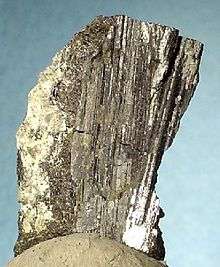Bismuthinite
| Bismuthinite | |
|---|---|
|
Bismuthinite - Schlaggenwald (Horni Slavkov) - Bohemia - Czech Republic (XX 1.1cm) | |
| General | |
| Category | Sulfide mineral |
| Formula (repeating unit) | Bi2S3 |
| Strunz classification | 2.DB.05a |
| Crystal system | Orthorhombic |
| Crystal class |
Dipyramidal (mmm) H-M symbol: (2/m 2/m 2/m) |
| Space group | Pbnm |
| Identification | |
| Color | Lead-gray to tin-white, with a yellowish or iridescent tarnish. |
| Crystal habit | Slender prismatic to acicular, massive lamellar |
| Cleavage | [010] Perfect |
| Fracture | Brittle - sectile |
| Mohs scale hardness | 2 |
| Luster | Metallic |
| Streak | Lead grey |
| Specific gravity | 6.8 - 7.2 |
| Optical properties | Opaque |
| References | [1][2][3] |
Bismuthinite is a mineral consisting of bismuth sulfide (Bi2S3). It is an important ore for bismuth. The crystals are steel-grey to off-white with a metallic luster. It is soft enough to be scratched with a fingernail and rather dense.
Bismuthinite forms a series with the lead, copper, bismuth mineral aikinite (PbCuBiS3).[3]

Bismuthinite crystal group from Bolivia (size: 2.9 x 1.9 x 1.5 cm)
It occurs in hydrothermal veins with tourmaline-bearing copper veins associated with granite, in some high temperature gold veins, and in recent volcanic exhalation deposits. Associated minerals include native bismuth, aikinite, arsenopyrite, stannite, galena, pyrite, chalcopyrite, tourmaline, wolframite, cassiterite and quartz.[1]
It was first reported in 1832 from the mines of Potosí, Bolivia.[2]
References
- 1 2 http://rruff.geo.arizona.edu/doclib/hom/bismuthinite.pdf Mineral Handbook
- 1 2 http://webmineral.com/data/Bismuthinite.shtml Webmineral Site
- 1 2 http://www.mindat.org/min-686.html Mindat mineral data
Further reading
| Wikisource has the text of the 1911 Encyclopædia Britannica article Bismuthite. |
This article is issued from Wikipedia - version of the 11/23/2016. The text is available under the Creative Commons Attribution/Share Alike but additional terms may apply for the media files.
